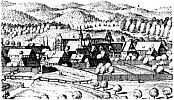City History
 We are in the Middle Ages after the turn of the first millennium. Emperor Charles The Great died more than 200 years ago, there is now Emperor Lothar III ruling. In Germany, at this time called "Holy Roman Empire of the German nation", there are already a few larger cities, especially in the South, and on the other hand, in the North, beside of the major habour cities, there are villages and mostly uninhabited areas. These are particularly interesting for the Christian monastic orders, because there are many natural resources yet untapped. So in 1129 the monks We are in the Middle Ages after the turn of the first millennium. Emperor Charles The Great died more than 200 years ago, there is now Emperor Lothar III ruling. In Germany, at this time called "Holy Roman Empire of the German nation", there are already a few larger cities, especially in the South, and on the other hand, in the North, beside of the major habour cities, there are villages and mostly uninhabited areas. These are particularly interesting for the Christian monastic orders, because there are many natural resources yet untapped. So in 1129 the monks  of the Cistercian Order of the Lower Rhine move to the Walkenried and find here a largely swampy area, but also fertile soil in the resin and further mineral resources that can be promoted by mines. With support of Adelheit von Walkenried, the decide the foundation of a monastery that is dedicated to 1137th Since then, this year is the actual founding date of Walkenried. of the Cistercian Order of the Lower Rhine move to the Walkenried and find here a largely swampy area, but also fertile soil in the resin and further mineral resources that can be promoted by mines. With support of Adelheit von Walkenried, the decide the foundation of a monastery that is dedicated to 1137th Since then, this year is the actual founding date of Walkenried.
The marshes were converted into ponds and used for fishing, so that an advanced  agriculture and fish farming provides a good food supply. The mines contributed a lot to the prosperity of the monastery, which became more and more wealthy and powerful by numerous other gifts and privileges and even founded other daughter monasteries. This golden age ended in the chaos of the Peasants' War of 1523-1525. Fanned by her leader Thomas Munzer, born in 1489 in Stolberg, a peasant army entered 1525 the monastery, plundered it and collapsed roof turret, so the monastery church got severely damaged (the rest of the monastery, however, remained mainly intact). With time passing, it fell into disrepair and was used as a quarry. In the agriculture and fish farming provides a good food supply. The mines contributed a lot to the prosperity of the monastery, which became more and more wealthy and powerful by numerous other gifts and privileges and even founded other daughter monasteries. This golden age ended in the chaos of the Peasants' War of 1523-1525. Fanned by her leader Thomas Munzer, born in 1489 in Stolberg, a peasant army entered 1525 the monastery, plundered it and collapsed roof turret, so the monastery church got severely damaged (the rest of the monastery, however, remained mainly intact). With time passing, it fell into disrepair and was used as a quarry. In the  19th Century, tehere were even 5 "Underling" houses in the nave. 1557 to 1668, as consequence of the Reformation, a Latin school for boys existed, which aimed to make Latin accessible for the general population. In 1648, the monastery fell to the Dukes of Brunswick and Lüneburg and later became part of the Brunswick monastery and university funds. From 1978 to 1989, extensive restoration works were carried out. Today, there are regular tours that convey a vivid idea of the influence of the Cistercian monastery and on their policy, architecture and business. 19th Century, tehere were even 5 "Underling" houses in the nave. 1557 to 1668, as consequence of the Reformation, a Latin school for boys existed, which aimed to make Latin accessible for the general population. In 1648, the monastery fell to the Dukes of Brunswick and Lüneburg and later became part of the Brunswick monastery and university funds. From 1978 to 1989, extensive restoration works were carried out. Today, there are regular tours that convey a vivid idea of the influence of the Cistercian monastery and on their policy, architecture and business.
Until 1958 it was also possible to travel with the Harz light railway to Braunlage and from there to the chunks or the resin, but unfortunately the tracks were dismantled in 1963 and scrapped. Still historically interesting is the gypsum industry, which has already been mentioned in documents from 1753. Even today, special plasters are made on the Röseberg.
|